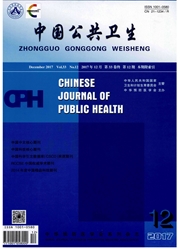

 中文摘要:
中文摘要:
目的测定渔村居民和饮水型砷暴露地区人群尿中各种形态砷和尿总砷(TAs)。方法选取饮水型砷暴露地区〔口肯板村水砷浓度为0.16 mg/L;乃莫板村水砷浓度为0.09 mg/L;塔布塞村(对照组)饮用水砷浓度〈0.01 mg/L〕和渔村居民。采用氢化物发生原子吸收分光光度法检测尿中各形态砷代谢物和TAs含量。结果 TAs含量渔村居民明显低于0.16 mg/L暴露组,高于对照组(P〈0.05),与0.09 mg/L暴露组差异无统计学意义;渔村居民尿无机砷(iAs)含量明显低于0.09和0.16 mg/L暴露组(P〈0.05);尿甲基砷(MMA)含量同尿二甲基砷(DMA)含量,各组之间差异均有统计学意义(P〈0.05);渔村居民尿iAs百分比明显低于对照组、0.09和0.16 mg/L暴露组(P〈0.05);尿MMA百分比同尿iAs百分比;各组尿DMA百分比差异均有统计学意义(P〈0.05);渔村居民特异性的检测出尿三甲胺(TMA)。结论人群尿总砷水平受食用海产品等因素影响,不能单独作为砷暴露指标,应使用分析性方法来区分砷复合物中无机砷和有机砷的代谢产物。
 英文摘要:
英文摘要:
Objective To determine the arsenic metabolites and total arsenic(TAs)in the urine of fishing village residents and residents exposed to arsenic in drinking water.Methods Three villages in Inner Mongolia with high(0.16 mg/L,0.09 mg/L) and normal arsenic(0.01 mg/L) in drinking water and a fishing village were selected.Hydride generation atomic absorption spectroscopy was used to detect urinary arsenic species among residents of the villages.Results The TAs of the residents in fishing village was lower than that of in residents exposed to water with 0.16 mg/L arsenic and higher than that of with 0.09 mg/L(P0.05).Urinary inorganic arsenic(iAs) in residents of fishing village was lower than that of the residents exposed to water with 0.09 mg/L and 0.16 mg/L arsenic with significanct differences between the residents of the four groups.The percent of urinary iAs in residents of fishing village was lower than that of residents in other three villages(P0.05).There were significant differences in urinary methyl arsenic and dimethyl arsenic between the residents of the four villages.Urinary trimethyl arsenic was detected only in residents of the fishing village.Conclusion Urinary TAs can not be used as the only indicator of arsenic exposure.Analytical methods must be used to distinguish urinary metabolite of inorganic arsenic and organic arsenic.
 同期刊论文项目
同期刊论文项目
 同项目期刊论文
同项目期刊论文
 Lack of association of glutathione-S-transferase omega 1(A140D) and omega 2 (N142D) gene polymorphis
Lack of association of glutathione-S-transferase omega 1(A140D) and omega 2 (N142D) gene polymorphis Effects of exogenous GSH and methionine on methylation of inorganic arsenic in mice exposed to arsen
Effects of exogenous GSH and methionine on methylation of inorganic arsenic in mice exposed to arsen Distribution and Speciation of Arsenic by Transplacental and Early Life Exposure to Inorganic Arseni
Distribution and Speciation of Arsenic by Transplacental and Early Life Exposure to Inorganic Arseni Correlation Analysis of Arsenic Methylation between Family members Exposed to High Concentrations of
Correlation Analysis of Arsenic Methylation between Family members Exposed to High Concentrations of Transplacental and early life exposure to inorganic arsenic affected development and behavior in off
Transplacental and early life exposure to inorganic arsenic affected development and behavior in off Association of oxidative stress with arsenic Methylation in chronic arsenic-exposed children and adu
Association of oxidative stress with arsenic Methylation in chronic arsenic-exposed children and adu Urinary arsenic speciation and its correlation with 8-OHdG in Chinese Residents exposed to arsenic t
Urinary arsenic speciation and its correlation with 8-OHdG in Chinese Residents exposed to arsenic t Monomethylarsonous Acid Induced Cytotoxicity and Endothelial Nitric Oxide Synthase Phosphorylation i
Monomethylarsonous Acid Induced Cytotoxicity and Endothelial Nitric Oxide Synthase Phosphorylation i 期刊信息
期刊信息
